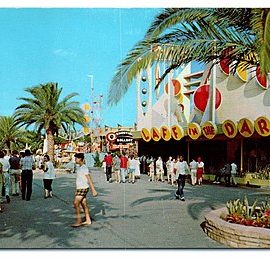
Katrina hit. The city evacuated. Buildings were flooded. Largely the buildings and homes were rebuilt but the population has not totally returned. I have a neighbor who would go back to Ohio – if her daughter and grandchild would come. They won’t. Others evacuated and found better jobs at higher pay and decided to stay. The population is rising but not up to pre-Katirina in all areas making an ineven recovery.
Adinas Perkins fondly recalls holidays growing up in Central City: Kids rode their bikes and tested out their new rollerskates. Family members crammed into her mother’s house. It didn’t take much to bring together an extended circle of relatives. After all, everyone lived on nearby blocks and was able to join celebrations, pitch in when someone needed help and keep an eye out for one another. In the diaspora after Hurricane Katrina, things have changed. Though many have returned – with some, like Perkins, only making it back to the city a decade or more after the flood – many others have not, straining the social and family networks that once stitched the city together. Perkins’ daughters now live in Baton Rouge and Houston, far from the city that had been the family’s North Star for generations. The networks that served as a source of joy and protection now often connect only remotely, even before the pandemic made such accommodations common. “Now everybody’s scattered. We’re doing conference calls,” Perkins said. “We’re not linking up, holding hands. You don’t have the camaraderie anymore, you don’t have the sense of home.”
nola.com
This is a common story and one I would expect after most disasters. Some will leave and come back and others will leave and stay gone.
A decade and a half after the levees failed and the city flooded, 384,000 people lived in New Orleans, according to the latest census figures. That’s 40,000 more residents than the city had in 2010, a population bump prompted by the long tail of the recovery and a sudden influx of newcomers drawn to a city that looms large in the nation’s cultural imagination. But it’s less than the city had in the middle part of the decade. And it leaves New Orleans with less than 80% of its pre-Katrina population, a presumably permanent gap of at least 100,000 people who never were able to make it back in a demographic shift that cut deeply into the city’s Black majority. With strong indications that its population is once again settling into the stagnation or slow decline that had defined it for a half-century, New Orleans finds itself at an existential crossroads. Reversing the slide, experts say, will mean building an economy beyond the often low-wage tourism jobs that now dominate and solving a housing crisis that has kept many from being able to afford to live in the city. “These kinds of trends, you can’t turn them around in a year. They take longer-term vision and implementation and commitment to a forward-looking vision,” said Allison Plyer, chief demographer for The Data Center.
As usual, there are many reasons and the economy and jobs are just some of them.
There is no single reason the recovery petered out with the city still so much smaller. Some of the displaced may have found personal or professional reasons to stay in the places they left for. But for many, the challenges of returning were immense. There were the inequities in how the Road Home program valued properties, which forced many homeowners to sell to the government because the payouts wouldn’t cover their repairs. Even for those who were able to renovate, there was difficulty in managing it from afar. Too, some areas of the city were hit harder than others. By far the most dramatic losses were in the “Big Four” public housing complexes, which were shut down by the City Council and razed to make way for a smaller number of mixed-income housing in the years after the storm. Less visibly, thousands of modest mom-and-pop rentals around the city flooded and were never brought back online or were converted into single-family homes. The result is a checkerboard. The Lower 9th Ward, obliterated during Katrina when the floodwall on the Industrial Canal failed, is now home to a mere 5,000 people, just more than a third as many as lived there two decades ago. Meanwhile, the Central Business District and Lower Garden District have a seen a boom in residents, more than doubling their population as former office towers were converted into condos and apartments. And areas near Tulane and Loyola universities as well as the University of New Orleans on the lakefront also now have more people than they did before the storm.
Some say the music has changed. Some the culture. Some the city as a whole. That can happen many ways even with out a disaster like Katrina.
As of 2020, a bare majority of the city’s residents, 53%, identified as Black. That’s compared to the two-thirds of the population before Katrina. Some portion of the change owes to changes to census questionnaires that encouraged people to provide more nuanced answers about their identity. The census now counts nearly 12,200 of New Orleans’ residents as multi-racial – almost three times as many as a decade ago – and there are an additional 2,000 people who do not identify with any of the government’s major racial classifications. As with its suburbs, particularly Jefferson Parish, the last decade has also seen the Hispanic population boom in New Orleans. A community that had numbered less than 15,000 before Katrina now numbers 31,000 and makes up about 8% of the city’s population.
Charting how the city has grown and where citizens have come is difficult. There are too many variables.
Exactly how much the city’s growth since 2010 came from residents returning and how much from newcomers is unknown, though there is ample anecdotal evidence that there are many in the latter group. Many of those new residents were drawn by housing costs that were cheap by the standards of other major metropolitan areas and a desire for culture and authenticity. Among millennials and Gen Z, New Orleans was widely seen as “an intriguing environment and a place in a story they wanted to be a part of,” Tulane University geographer Richard Campanella said, comparing it to the “cultural renaissance” of the 1920s in the French Quarter. The influx of new residents is a daily reality in Holy Cross, said Calvin Alexander, who heads the neighborhood’s homeowners association. Still at only 63% of its pre-Katrina population, the neighborhood — which abuts the Lower 9th Ward — has seen a steady stream of people buying homes from Chicago, Seattle, Portland, New York and elsewhere.
I can offer the story of 6. My son-in-law is a doctor who was at Charity Hospital and evacuated with the patients. He came back. My son came down the year after Katrina to get his masters at Tulane. He teaches at Newman. They adopted two local children. When the adoption process started with the second, they asked us to come down and help. We left Virginia and got here in mid-2015. We bought a renovated home, renovated long after Katrina in uptown just off Napoleon and Freret. They moved to Broadmoor from the Warehouse district for more bedrooms into a renovated home. Another story follows.
Alexander bought in Holy Cross in 1978, finding it provided many of the benefits of more suburban areas people were relocating to on the north shore without the headaches of a commute. He said the new homeowners have been a good addition to the neighborhood and by and large have integrated themselves well into a community where some residents live in homes their families have owned for generations. But, he said, housing prices have gone haywire. It used to be that $100,000 would buy a “fairly substantial home,” but now “it’s nothing” to see small houses go for between $175,000 and $300,000. “For those who want to sell and want to realize their lifelong investment, it’s a good thing,” Alexander said. “On the other hand, my daughter lives in a property that my wife and I own as a rental, and she wants to live in Holy Cross, and frankly she can’t find a thing to buy.”
But what of the city at large?
For Plyer, the key question is not necessarily how many people are coming from elsewhere. Indeed, the very vibrancy of the city may owe to the constantly changing demographics and the interplay of cultures and ideas. The more important questions, she said, may be: “Are the culture-bearers able to afford to live in a city? Are we paying our culture-makers a living wage? “Those are the things that matter a lot more to our culture than whether new people are coming or not.”
Quite possibly we have reached our peak population and will not get back to pre-Katrina.
Even before the 2020 census, there were indications that New Orleans’ post-Katrina population had already peaked. Census Bureau estimates showed a 2016 high of about 392,300 residents. After that, a decline due to outmigration resumed, a trend that has been the rule in New Orleans demographics since the population hit 628,000 in 1960. The recent outmigration now appears to be driven by low-income workers who can no longer afford to live in the city. Cashauna Hill, executive director of the Louisiana Fair Housing Action Center, returned to the city herself in 2011. She noted that as more people were priced out of the city, the suburbs absorbed some working-class people – which has helped fuel the diversification of Jefferson Parish and St. Bernard. But the lack of a functional regional public transit system has made it difficult for many of them to get to jobs in the city. “You have to keep in mind that low-income workers who have been displaced to the suburbs, a large percentage of those people are there without their own personal vehicle,” she said. “It’s not that far away in a car, but if you don’t have a car, it’s a world away from New Orleans.” This forces lower-income residents to either take jobs in the suburbs, or move to other metro areas with better transit options, like Atlanta or Houston. HousingNOLA, which advocates for increasing affordable housing, notes that 58,200 low- to moderate-income people commute into the city every day and argues they could be enticed to live there given the opportunity. To do so would require making use of some of the nearly 20,700 vacant properties in the city, according to a forthcoming report from the group.
I know I could not afford to by my house now. It is good when I sell but not if I have to buy a similar one.
For Perkins, the explosion in housing costs over the past decade was shocking. After living in the city for much of her life, Perkins moved to Georgia a couple years before the storm. When she sought to come back in 2013, she was dumbfounded to find that apartments she had expected to rent for a few hundred dollars were going for nearly $1,000. For a few years she lived with a roommate in Slidell. She was only able to return to the city after her mother asked a tenant who was renting one side of the family double to leave. But while she made it back, it has been a different story for her two daughters. One daughter moved to Texas after getting her doctorate at Tulane, saying she couldn’t find a job that would pay enough in Louisiana. Her other daughter commutes from Baton Rouge for phlebotomy training because she can’t afford the city. “The average person in my community works at a fast-food restaurant or some other minimum wage job. So we definitely could not afford to purchase the homes in the neighborhoods now, because they’re buying and renovating and selling at a rate we can’t afford,” she said. “If you don’t already own a home, you probably will never own a home, and investors will make sure you never own a home. And they will make sure you don’t rent in certain neighborhoods because the rent is so high.”
There may be changes coming but they won’t hep those looking now.
Michael Hecht, who heads the regional economic development organization GNO Inc., pointed to at least two hopeful signs for the city’s future. The recent sales of New Orleans start-ups, including a $1 billion deal for survey and analysis company Lucid, has “put a fire in the belly” of the business community, he said. And the possibility that the pandemic-driven trend toward remote work will encourage more people who like New Orleans but work elsewhere to move here. But taking advantage of either will require efforts, both in terms of policy and perception, he said. “We need to have three areas of focus: first, on acute issues like infrastructure and public safety; second, on the strategic issue of economic diversification; and finally, on driving a narrative that makes greater New Orleans a place people want to grow both their business, and their family – there has to be an attractive brand, with a reality to back it up,” Hecht said. Some of those who have managed to make it back, even belatedly, also see signs of hope. For much of her childhood, 23-year-old Tashia Gaspard’s family bounced between New Orleans and Georgia. But she always felt connected to a city where her family has roots going back to the 1700s. Returning wasn’t easy. When she moved down in 2019, Gaspard spent time in the city’s low-barrier homeless shelter before she got settled and started her own business. While the city has changed, Gaspard said that she sees a bright future for New Orleans. “We know New Orleans is always going to change,” Gaspard said. “The river deposits, but it will always over the years change course. It’s up to us to make sure it doesn’t go too far away.”
Change, the only constant in life is change. As she said, it is u[ to us to manage the change and not have it manage us.



